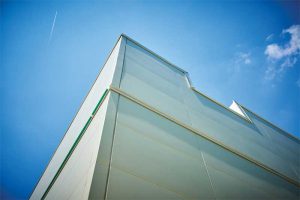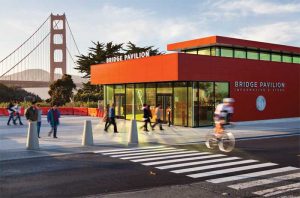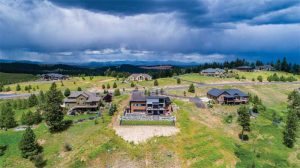
Fiber-cement siding installed in front of concrete block construction satisfying ASTM C90, Standard Specification for Loadbearing Concrete Masonry Units, for loadbearing concrete does not require impact and positive pressure tests for HVHZ approval. The same is true for fiber cement installed in front of 16-mm (5/8-in.) plywood supported by 406-mm (16-in.) on center (o.c.) 2x wood or metal framing. Still, some fiber cement manufacturers have conducted impact testing to measure how their products would perform in a hurricane. Tests might include blasting a 2×4 from a 90-degree angle perpendicular to it at 145 km/h (90 mph) to determine weak or unsupported points.
Fiber cement’s capacity for wind resistance varies by product and installation. Commercial-grade panels are engineered to withstand high wind loads, along with an option to install with high-performance hardware. To meet the challenge of unusually high wind loads, commercial panel framing can be upgraded from 18 to 16-gauge metal to strengthen the hold of the panel’s fasteners or use steel hardware instead of aluminum for added strength.
Fire
In encounters with fire, wood siding quickly becomes fuel and vinyl melts. Fiber-cement siding—consisting of mostly nonflammable cement and silica—resists combustion. Organizations such as ASTM, the National Fire Protection Association (NFPA), and the Underwriters Laboratories of Canada (ULC) have developed an array of tests for utilization by manufacturers and governments to measure the ignition resistance, combustibility, and flame spread in building/wall products. Tests include:
- ASTM E84;
- ULC S102-10, Standard Method of Test for Surface Burning Characteristics of building Materials and Assemblies;
- ULC S134-13, Standard Method of Fire Test of Exterior Wall Assemblies;
- NFPA 268, Standard Test Method for Determining Ignitability of Exterior Wall Assemblies Using a Radiant Heat Energy Source; and
- NFPA 285, Standard Fire Test Method for Evaluation of Fire Propagation Characteristics of Exterior Non-Load-Bearing Wall Assemblies Containing Combustible Components.

These tests allow manufacturers to prove fiber cement may be safely used with wall assemblies that organizations have rated as fire-resistant. Manufacturers have also demonstrated which fiber cement products have a flame spread index (FSI) of zero and qualify as Class A building materials under ASTM E84.
Fiber cement’s proven capacity for resisting fire is particularly relevant to the people who live and work in California, Colorado, Idaho, Ohio, Montana, Nevada, Wyoming, and other areas at high-risk for wildfires. In chapter 7 of the state’s building code, California (a trendsetter when it comes to codes and construction) established standards and guidelines for materials and construction methods to help increase a building’s fire resilience and the survivability of people and property located in areas designated as fire hazard severity zones or wildland-urban interface (WUI) fire areas. Fiber cement products have been tested and proven for use in WUI areas and can help protect buildings from ignition by embers that can fly as far as a mile away from a wildfire.
California’s Office of the State Fire Marshal (SFM) manages the Building Materials Listing (BML) Program that lists tested and approved products (including fiber cement) in compliance with Chapter 7A of the California Building Code (CBC). To be listed in BML, all products must be tested and labeled by an SFM-accredited laboratory. Fiber cement is assessed under testing standard CA SFM 12.7A-1, Exterior Wall Siding and Sheathing.
While using tools like California’s BML to choose compliant products will increase overall fire resistance, fiber cement could not make a home or business completely invulnerable to fire. Fiber cement provides another layer of protection for people and property. To achieve optimal results in terms of fire resistance, it is best to follow best practices such as keeping at least 152 mm (6 in.) of clearance between siding and combustible items such as plants or mulch.
Case in point
In October 2017, a series of 250 destructive wildfires spread across northern California. The Tubbs Fire alone resulted in the deaths of 22 people and the destruction of more than 5643 buildings across Lake, Napa, and Sonoma counties. Another fire, the Redwood Valley Mendocino Lake Complex Fire, burned 14,780 ha (36,523 acres) before it was contained.

In Redwood Valley, California, one homeowner watched as the latter incinerated every house in his neighborhood, including his own place. No structure was left standing except for a standalone home office on his property that endured in part because of the resilience enabled by its fiber cement cladding.
The homeowner built his 130-m2 (1400-sf) standalone home office roughly 10 years ago. With ample room on the 2-ha (5-acre) property, the office stood 53 m (175 ft) away from a 186-m2 (2000-sf) home built 16 years ago. Flanked by vineyards to the west and north, the primary home was custom-built with a marble entryway, solid fir doors, hardwood floors, and redwood siding, among other high-end details. The property also included a 279-m2 (3000 sf) deck made of redwood.
The family opted to use fiber-cement siding for the home office because it would match the look of their redwood home but require significantly less maintenance. Prefinished siding with machine-applied coating is engineered to provide long-lasting color, enhanced durability, and a consistent appearance.
When the fires approached, the homeowner tried to save his home, but wind gusts of 80 to 96.5 km/h (50 to 60 mph) were spreading the flames too rapidly to be combatted. The fire consumed the custom-built home within 15 minutes, and for the next three hours, the home office was battered with embers and wind gusts reaching upwards of 96.5 km/h. Despite the extreme conditions, the fiber-cement siding and the home office remained intact and largely unaffected. The family lost their primary home in the historic wildfire, but they have continued to live on their property by relocating into the home office.
Fiber cement is not magic, but when applied per manufacturer-recommended installation instructions and best practices, it maintains its attractiveness in the face of environmental threats and enables homeowners and businesses to better protect structures and people. As another layer of protection from sun exposure, humidity, snowfall, and even wildfires, fiber cement improves resilience while retaining the versatility to satisfy a wide range of aesthetic preferences.
David Hohenstern is a technical manager at Nichiha USA. Based in John’s Creek, Georgia, Hohenstern leads the team providing customer and sales support, project reviews, the creation and management of technical documents, research and development, product testing, and building code compliance-related functions for Nichiha’s product lines. He holds a master of science degree in building construction and facility management from Georgia Tech. Hohenstern can be reached at dhohenstern@nichiha.com.




